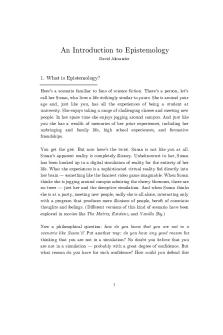Epistemology of the Closet by Eve Kosofsky Sedgwick PDF

| Title | Epistemology of the Closet by Eve Kosofsky Sedgwick |
|---|---|
| Course | StuDocu Summary Library EN |
| Institution | StuDocu University |
| Pages | 1 |
| File Size | 42 KB |
| File Type | |
| Total Downloads | 8 |
| Total Views | 145 |
Summary
Download Epistemology of the Closet by Eve Kosofsky Sedgwick PDF
Description
Epistemology of the Closet by Eve Kosofsky Sedgwick Because its major purpose is to show how the late nineteenth century “crisis” of homosexual/heterosexual identity reverberated throughout twentieth century Western culture, Epistemology of the Closet cannot be assigned to a single discipline or field of study. The book cuts across the boundaries of gay and lesbian studies, cultural studies, and literary criticism. Readers who are largely unfamiliar with the basic principles and vocabulary of deconstruction, psychoanalytic theory, and other contemporary cultural and literary theories will find Sedgwick’s analyses difficult, if not impenetrable, at points, as she often relies heavily on technical terminology. (She attempts in her introduction to define terms and concepts, but her explanations are themselves often filled with jargon and abstractions.) Yet, if the writing style is often opaque, it is also often remarkably personal, even confessional. As she explains in the introduction, a main strand of argument in her book is “deconstructive.” In other words, she attempts to demonstrate that homosexual/heterosexual, masculine/feminine, knowledge/ignorance, private/public, secrecy/disclosure, and a host of other “symmetrical binary oppositions” are inherently unstable and incoherent because each paired term is dependent on its opposite for its meaning. For example, any definition of “public” must somehow hinge on an understanding of “private,” and vice versa. As part of her deconstructive enterprise, Sedgwick argues in the introduction and illustrates in later chapters that the modern term “homosexual” is, first, inextricably fused with the concept of heterosexuality; and, furthermore, that homosexuality has been defined in quite different ways. For example, Sedgwick notes that while some consider a gay man to be effeminate (a woman in a man’s body), others see the gay male as being the epitome of masculinity (with a desire for complete “male bonding”). She also discusses, but does not attempt to settle, the ongoing debate about whether homosexual identity is a product of one’s genes (the “essentialist” position) or of one’s personal and cultural experience (the “social constructivist” position)....
Similar Free PDFs

Genealogy of Adam - Eve
- 1 Pages

Epistemology- Part 1
- 3 Pages

Secret-adam-eve
- 3 Pages

Eve Madison vSim-Pediatrics
- 17 Pages

1. An Introduction to Epistemology
- 10 Pages
Popular Institutions
- Tinajero National High School - Annex
- Politeknik Caltex Riau
- Yokohama City University
- SGT University
- University of Al-Qadisiyah
- Divine Word College of Vigan
- Techniek College Rotterdam
- Universidade de Santiago
- Universiti Teknologi MARA Cawangan Johor Kampus Pasir Gudang
- Poltekkes Kemenkes Yogyakarta
- Baguio City National High School
- Colegio san marcos
- preparatoria uno
- Centro de Bachillerato Tecnológico Industrial y de Servicios No. 107
- Dalian Maritime University
- Quang Trung Secondary School
- Colegio Tecnológico en Informática
- Corporación Regional de Educación Superior
- Grupo CEDVA
- Dar Al Uloom University
- Centro de Estudios Preuniversitarios de la Universidad Nacional de Ingeniería
- 上智大学
- Aakash International School, Nuna Majara
- San Felipe Neri Catholic School
- Kang Chiao International School - New Taipei City
- Misamis Occidental National High School
- Institución Educativa Escuela Normal Juan Ladrilleros
- Kolehiyo ng Pantukan
- Batanes State College
- Instituto Continental
- Sekolah Menengah Kejuruan Kesehatan Kaltara (Tarakan)
- Colegio de La Inmaculada Concepcion - Cebu










